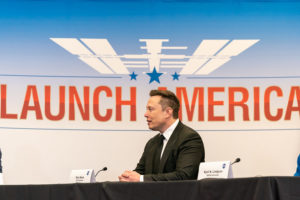
Elon Musk, founder of Space Exploration Technologies Corp.- SpaceX, joins President Donald J. Trump at a launch briefing in preparation for the launch of the SpaceX Falcon 9 rocket with the Crew Dragon vehicle Wednesday, May 27, 2020, at the Kennedy Space Center in Cape Canaveral, Fla. (Official White House Photo by Shealah Craighead)
“The perception is sort of the driving factor.” It’s a “psychological boost.” These words spoken by directors at wealth funds refer to stock splits. Despite having little to no effect on the value of a company’s shares, stock splits are popular with investors. Tesla recently announced it would seek to split its stock again. The Wall Street Journal reports:
Tesla Inc. on Monday said it would seek to split its highly priced stock for the second time in two years. Already in 2022, both Google parent Alphabet Inc. and Amazon.com Inc. have unveiled plans for 20-for-1 splits.
Stock splits themselves don’t change the value of a company or the worth of shareholders’ investments. But investors often interpret such plans as signals of confidence by management, and they snapped up shares of all three companies after the news.
Tesla shares climbed 8% to $1,091.84 on Monday, while Alphabet and Amazon rose 7.4% and 5.4%, respectively, in the trading sessions after the companies said splits were in the works. Alphabet shares are up 3.9% since the Feb. 1 announcement, and Amazon is up 22% since March 9.
“It has this connotation that a stock isn’t splitting unless the company is successful and they expect the price to go even higher and higher,” said Jamie Cox, managing partner for Harris Financial Group. “That perception is sort of the driving factor.”
Once more common, stock splits had seemed to be falling out of favor as more companies let their share prices climb. The rationale for the comeback? Some companies say a stock split makes their shares more accessible to a wider range of investors.
In the case of Tesla, individual investors don’t appear to be waiting for the split to take effect. They piled into shares of the electric-vehicle maker Monday, buying a net $37 million in stock, the highest one-day total in two months, according to VandaTrack.
Investors intrigued by the potential split still have questions, including when Tesla might divide its stock and how many shares they will receive for each existing one.
Tesla said Monday that it would ask shareholders at its annual meeting, which typically takes place in the fall, to approve an increase in the authorized number of shares to enable a stock split. The company is currently authorized to issue two billion shares, and as of late January had 1.03 billion shares outstanding.
Back in 2020, Tesla’s announcement of its first stock split also set off a buying spree.
The day after the company said it would split its shares 5-for-1, individual investors bought a net $39.5 million of its shares, more than 11 times as much as in the previous session, VandaTrack data show. The stock was trading above $1,300 at that point.
Over the 14 trading days through Aug. 31, when shares began trading on a split-adjusted basis, retail traders purchased a net $1.3 billion in Tesla stock. That was more than four times as much money as they had put into Tesla on a net basis over the previous 14 sessions.
Read more here.
